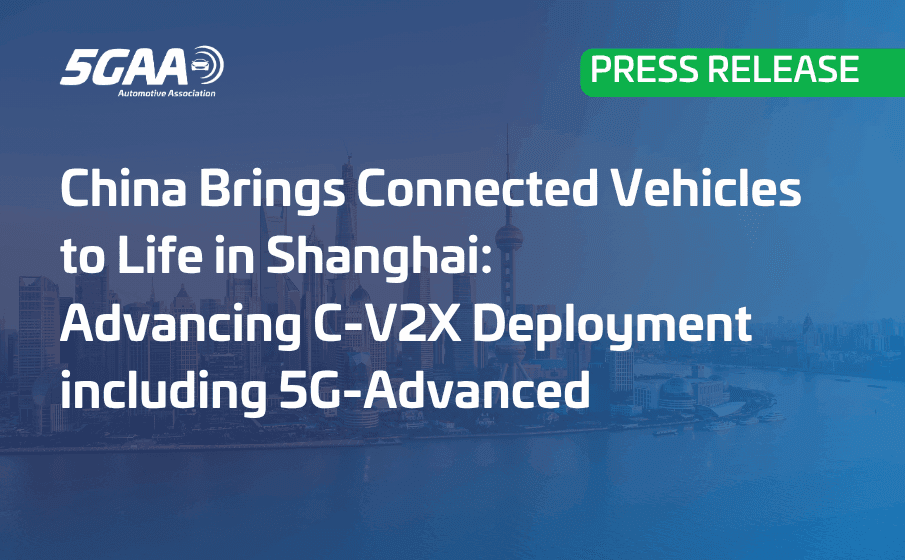
China Brings Connected Vehicles to Life in Shanghai: Advancing C-V2X Deployment including 5G-Advanced
Shanghai, 23 October 2025 — In Jiading, Shanghai, the 5G Automotive Association (5GAA) and Shanghai International Automobile City (SIAC) co-hosted the “C-V2X Implementation in China and International Cooperation” Conference. The full-day event brought together global experts for high-level strategic discussions and live demonstrations, highlighting China’s rapid progress in C-V2X innovation while fostering dialogue across the international connected mobility ecosystem and showcasing the capabilities powered by 5G-Advanced (5G-A)
“The Shanghai conference and demonstrations highlighted China’s proactive role in advancing C-V2X technologies. It is particularly significant as it showcases leadership and innovation that drive progress across the entire global ecosystem,” said 5GAA Director General Christof Schmidt.
Attendees witnessed live demonstrations of cutting-edge C-V2X technologies. China IMT-2020(5G)Promotion Group C-V2X Working Group and SIAC presented the “Four Layers Demonstrations”, which included scenarios such as sudden cut-outs by preceding vehicles, work-zone alerts, and connected-assisted driving. These tests highlighted how advanced onboard units can receive real-time data from multiple vehicles ahead, enabling rapid adjustments and improving safety. Additionally, demonstrations also showcased how C-V2X enhances vehicle awareness under challenging weather conditions.
In parallel, SIAC, AUMOVIO and China Unicom showcased C-V2X vehicle networking applications based on 5G-A network. Leveraging the 5G-A network, cross-operator real-time sensor information sharing between vehicles and on-demand information distribution between vehicles and infrastructure are achieved. The system supports typical application scenarios such as front-object detection, blind spot communication, and emergency collaboration. With end-to-end latency below 20ms, it meets the stringent low latency and high reliability requirements of C-V2X applications.
“We are honoured to co-host this international forum with 5GAA,” said Gang Chen, Chairman of Shanghai International Automobile City. “As China’s first national pilot zone for intelligent and connected vehicles, SIAC is actively contributing China’s practical experience and fostering global industrial synergy through our deep involvement in prestigious international organisations such as 5GAA and VDA. We are committed to building an open, integrated, and globally influential industrial ecosystem, accelerating the alignment and mutual recognition of Chinese solutions with international standards, and sharing ‘China’s Wisdom’ and the ‘Shanghai Model’ with the world. We look forward to joining hands with global partners in pioneering a new chapter for intelligent and connected mobility,” he said.
The C-V2X Chinese Solutions and International Cooperation Conference marked a milestone in advancing global dialogue on connected mobility. By combining strategic discussions with practical demonstrations, the event reaffirmed the shared commitment of 5GAA and SIAC to driving forward C-V2X innovation and international cooperation.
About the 5GAA
The 5G Automotive Association (5GAA) is a global, cross-industry organisation of more than 110 members, including leading global automakers, Tier-1 suppliers, mobile operators, semiconductor companies, and test equipment vendors. 5GAA members work together to develop end-to-end solutions for future mobility and transport services. 5GAA is committed to helping define and develop the next generation of connected mobility, automated vehicles, and intelligent transport solutions based on C-V2X. For more information about 5GAA, please visit www.5gaa.org.
Media contact: marcom@5gaa.org
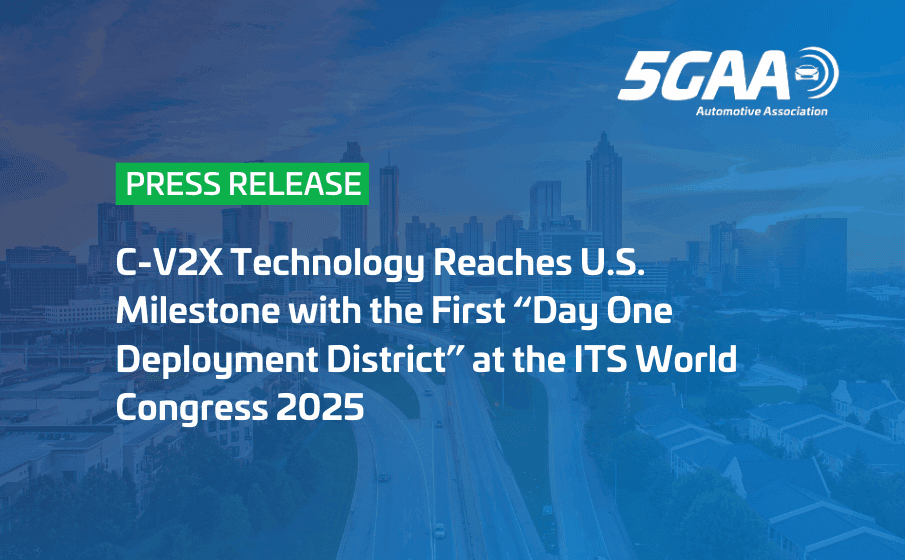
C-V2X Technology Reaches U.S. Milestone with the First “Day One Deployment District” at the ITS World Congress 2025
- The 5GAA Day One Deployment Guide was instrumental in enabling the largest C-V2X deployment during the “Day One Deployment District” in Atlanta.
- 5GAA members demonstrated real-world C-V2X applications showing immediate public value and nationwide scalability.
ATLANTA, U.S. – 3 September 2025 — The U.S. connected vehicle ecosystem took a major step forward as Atlanta became home to the nation’s first “Day One Deployment District” for Cellular Vehicle-to-Everything (C-V2X) technology. The 5GAA Vehicle-to-Infrastructure Communications Day One Deployment Guide was instrumental as a benchmark for C-V2X roadside infrastructure installations such as those earning the spotlight at the ITS World Congress 2025 for the Georgia Department of Transportation (GDOT) and the permanent enhancements for the downtown district.
5GAA members played a key role in showcasing ready-now applications for C-V2X technology in a live urban traffic environment and the clear potential for deployment in other states and cities.
This milestone comes at a moment when vulnerable road user traffic fatalities remain near the highest levels ever recorded, and with traffic congestion costing the U.S. economy more than $36 billion[1] annually. With an estimated nationwide deployment cost of $6.5 billion, as estimated in the ITS America National V2X Deployment Plan, C-V2X offers a powerful solution to enhance road safety.
“Day One Deployment District” also builds a bridge for establishing the C-V2X ecosystem in Atlanta, as OEMs progress from pilot projects toward production-ready architectures. Live demonstrations by 5GAA members and other industry leaders illustrated how C-V2X can offer immediate public value through:
- Faster emergency response with traffic signal preemption and real-time alerts
- Enhancing safety for vulnerable road users
- Lower local agency expenses, reducing costs for school buses and public fleets
- Streamlining tolling and parking through seamless digital transactions
John F. Kwant, Executive Director Americas, 5GAA, said, “Atlanta’s Day One Deployment District proves that C-V2X is ready for prime time. As the global cross-industry association for connected vehicle technologies, 5GAA has worked with its members, public agencies, and technology leaders to turn C-V2X deployment guides into reality. This milestone shows what’s possible when we align standards, infrastructure, and industry commitment”.
With the “Day One Deployment District” anchoring C-V2X in Atlanta, opportunities will also emerge for streamlined revenue streams for local agencies and toll operators. The deployment confirms the State of Georgia’s position as a champion of connected-transportation innovation.
Please see our brochure about the 5GAA members’ innovations here.
About the 5GAA
The 5G Automotive Association (5GAA) is a global, cross-industry organization of more than 110 members, including leading global automakers, Tier-1 suppliers, mobile operators, semiconductor companies, and test equipment vendors. 5GAA members work together to develop end-to-end solutions for future mobility and transport services. 5GAA is committed to helping define and develop the next generation of connected mobility, automated vehicles, and intelligent transport solutions based on C-V2X. For more information about 5GAA, please visit www.5gaa.org. Media contact: marcom@5gaa.org
[1] The Economic and Societal Impact of Motor Vehicle Crashes, 2019 (Revised): https://crashstats.nhtsa.dot.gov/Api/Public/ViewPublication/813403.pdf

Driving the Future: 5GAA Brings First-Ever Satellite and 5G-V2X Direct Vehicle Connectivity to Life in Paris
- In a global premiere, 5GAA members demonstrated connected vehicles using non-terrestrial networks (NTN), complementing terrestrial 4G and 5G networks
- The event featured the first on-the-road, live-traffic demonstration of 5G-V2X Direct technology capabilities for advanced connected mobility services
- 5GAA members showcased ready-to-deploy vehicle-to-network (V2N) technologies improving road safety in real traffic conditions
PARIS, 15 May 2025 — For the first time worldwide, the 5G Automotive Association (5GAA) showcased connected vehicles using non-terrestrial networks (NTN) for emergency messaging, as well as 5G-V2X Direct for advanced detection of vulnerable road users (VRU) in real-traffic conditions. 5GAA members also demonstrated the readily available capabilities of Vehicle-to-Network (V2N) services.
“Today, we saw real vehicles on real roads, connected through cutting-edge technologies such as satellite, 5G-V2X Direct and commercial networks. This is the future of automotive connectivity, and it’s closer than you think,” said 5GAA Chairman Christoph Voigt.
5GAA members, vehicle manufacturers BMW Group and Stellantis and technology partners Anritsu,Cubic³, Deutsche Telekom, HARMAN, Jember, LG Electronics, Qualcomm Technologies, MediaTek, Rohde & Schwarz, Rolling Wireless, Skylo, VEDECOM Institute and Viasat demonstrated NTN satellite connectivity. Demonstrations focused respectively on realising hazard warning and emergency messaging use cases in the vehicle, as well as illustrating how NTN will complement terrestrial 4G and 5G networks in the future. Demonstrations on public roads emphasised the vision of how NTN can support ubiquitous automotive connectivity for connected services with seamless integration and switching between NTN and terrestrial networks to enable voice communication. In the future, car drivers may not even realise that satellite connectivity is being established instead of using a terrestrial network. According to 5GAA 2030 Roadmap, the initial market deployment of satellite connectivity in vehicles is expected by 2027 (based on IoT NTN 3GPP Release 17).
Anritsu, Keysight Technologies, Rohde & Schwarz, and MediaTek complemented the NTN demonstrations with parallel test equipment measurements for performance verification.
For the first time on the road, 5GAA member Valeo, in collaboration with Marben, demonstrated 5G-V2X Direct, in which two vehicles shared sensor data, triggering a warning of a pedestrian crossing at an obstructed intersection. This demonstration illustrated how 5G-V2X Direct (based on 3GPP Release 16) will enable vulnerable road users’ advanced protection by leveraging sensors and camera feeds from other vehicles to alert drivers, paving the way for smarter mobility. As per the 5GAA Visionary 2030 Roadmap, 5G-V2X is expected to be mass-deployed in commercial vehicle models starting from the time horizon 2026-2029.
The public road demonstrations continued with V2N technology for road users’ protection. 5GAA members, including Nokia, Orange, Stellantis, Valeo, and VEDECOM Institute, showcased interoperable V2X Platforms with vehicles, mobile applications and smart intersections (equipped with cameras and connected via the 5G networks) sharing collective perception to enhance road users’ safety. Additionally, HARMAN and u-blox showcased Emergency Electronic Brake Light (EEBL) near-real-time alerts to prevent hard braking events, in line with the upcoming 2026 Euro NCAP local hazard requirements, and used precise positioning techniques to prevent false alerts.
5GAA members Rohde & Schwarz, S.E.A., Keysight and Orange alsoexhibited Next Generation Emergency Call (NG eCall) verification and network performance.
The event, hosted by Telecom-Paris, highlighted how 5GAA is developing new standards for safety and innovation in automotive connectivity in Europe and globally.
Please see our brochure about the Paris demonstrations here.
A French version of this press release is also available for our French-speaking audience here.
Discover What Our 5GAA Members Are Saying here.
About the 5GAA
The 5G Automotive Association (5GAA) is a global, cross-industry organisation of more than 110 members, including leading global automakers, Tier-1 suppliers, mobile operators, semiconductor companies, and test equipment vendors. 5GAA members work together to develop end-to-end solutions for future mobility and transport services. 5GAA is committed to helping define and develop the next generation of connected mobility, automated vehicles, and intelligent transport solutions based on C-V2X. For more information about 5GAA, please visit www.5gaa.org.
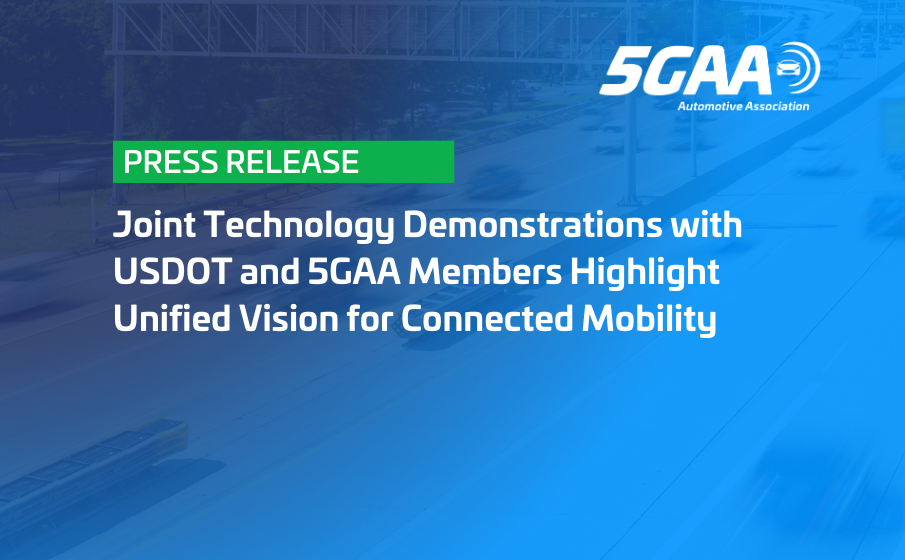
Joint Technology Demonstrations with USDOT and 5GAA Members Highlight Unified Vision for Connected Mobility
Washington, D.C., 6 February 2025 – For the first time, the U.S. Department of Transportation (USDOT) and members of the 5G Automotive Association (5GAA) have partnered to showcase the complementarity of Cellular Vehicle-To-Everything (C-V2X) direct and mobile network communications at the Federal Highway Administration’s Turner-Fairbank Highway Research Center.
The live demonstrations illustrated the potential of connected-vehicle technologies to make American roads safer and more efficient. This public-private initiative also outlined the benefits of interworking communication modes for a unified transportation system.
“5GAA commends USDOT for its leadership in advancing V2X technology through government-industry collaboration, critical for nationwide deployment,” said 5GAA Chairman Christopher Voigt. “We applaud USDOT’s commitment to seizing the full safety potential of V2X by integrating direct and mobile network communications to achieve 360° awareness.”
Participants had the opportunity to experience several use cases:
- Verizon showcased near real-time alerts enabled by C-V2X mobile network communications and mobile edge computing (MEC). Demonstrated capabilities included connected signalized intersection and delivery of pedestrian alerts, variable speed warnings, and weather warnings.
- Audi, in collaboration with Spoke and the Coalition for Cyclist Safety, used C-V2X direct communications to address safety scenarios that often result in cyclist fatalities. The seamless integration of aftermarket solutions and in-vehicle systems is a clear example of leading automakers’ increasing interest in this technology.
- Autotalks illustrated how C-V2X direct communications can prevent same-lane accidents: in their demo, a car swerved abruptly to avoid a stopped bicycle, showcasing the system’s potential to protect cyclists outside intersections.
5GAA also gathered industry and government leaders to identify main drivers for deployment, such as the reauthorization of federal transportation funding. The event underpinned the critical role of C-V2X in achieving USDOT’s National Roadway Safety Strategy targets, as well as the industry’s commitment to help implement the National V2X Deployment Plan released in August 2024.
With this, the foundation is laid to leverage the existing tens of millions of connected road users and accelerate the nationwide rollout of connected-vehicle and connected-road infrastructure technologies, bringing us closer to the shared vision of zero traffic fatalities on American roads.
About 5GAA
The 5G Automotive Association (5GAA) is a global, cross-industry organization of more than 110 members, including leading global automakers, Tier-1 suppliers, mobile operators, semiconductor companies, and test equipment vendors. 5GAA members work together to develop end-to-end solutions for future mobility and transport services. 5GAA is committed to helping define and develop the next generation of connected mobility, automated vehicles, and intelligent transport solutions based on C-V2X. For more information about 5GAA, please visit www.5GAA.org.
For further information please contact:
5GAA Marketing & Communications – Marcom@5GAA.org
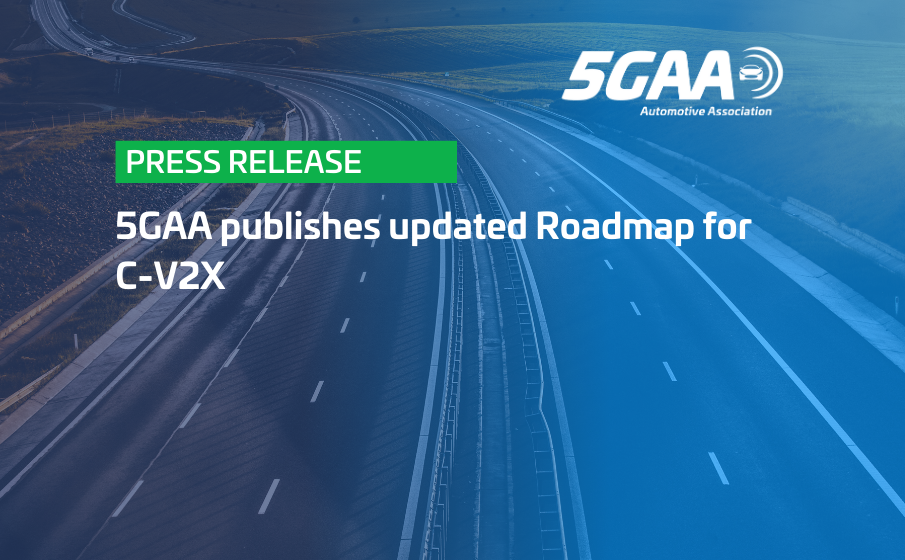
5GAA publishes updated Roadmap for C-V2X
BRUSSELS, 3 December 2024 – The 5G Automotive Association (5GAA) has sketched out an upbeat vision for better transportation safety, efficiency and sustainability with the third edition of its Roadmap for advanced driving use cases, connectivity, and technologies.
The 24-page Roadmap III builds upon a 5GAA white paper first published in 2020 and updated in 2022. It includes both a summary of market and technological developments since the last report as well as a forecast of the market readiness and roll-out of connected mobility technologies through 2030, with a focus on cellular-vehicle-to-everything (C-V2X) technology.
Thanks to the rapid expansion of cellular networks worldwide, about 300 million vehicles, including about two-thirds of all cars sold in the world’s major automotive markets, are now “connected.” Moreover, road and other infrastructure owners and operators have continued to expand a network of roadside sensors, traffic lights and other devices that help make transportation smarter, safer—including for pedestrians, cyclists and other vulnerable road users—and more sustainable.
While most vehicles and infrastructure to-date have relied on C-V2X technology to communicate with one another via cellular networks, the Roadmap also sees a growing role for “direct” vehicle-to-vehicle and related communications as soon as two years from now. 5GAA expects 5G-V2X Direct-enabled vehicles and related services to begin to be mass-deployed between 2026 and 2029, starting in Europe.
In addition, the third edition of the Roadmap for the first time describes a timeline for new use cases enabled by non-terrestrial networks and advanced Multi-Access Edge Computing (MEC). Satellite connectivity could help guarantee ubiquitous service in rural areas and disaster situations as soon as 2027, for example.
“Connected vehicle technologies and the market have both come a long way, since 2000,” said Maxime Flament, 5GAA Chief Technology Officer. “Our latest Roadmap foresees the continuous evolution of C-V2X cellular and direct communications technologies that will help save lives, make transportation more efficient and more sustainable and accelerate the spread of autonomous vehicles,” he said.
5GAA sees the Roadmap as a guide to help vehicle manufacturers, telecommunications network operators, road and other infrastructure owners and operators, as well as governments, understand the investments, speed and spectrum requirements needed to ensure the most efficient deployment of the new technologies and services. This, in turn, can help governments achieve their stated vision of zero road fatalities more quickly and also expedite the deployment of autonomous vehicles.
You can download the full Roadmap here.
About 5GAA
The 5G Automotive Association (5GAA) is a global, cross-industry organization of more than 115 members, including leading global automakers, Tier-1 suppliers, mobile operators, semiconductor companies, and test equipment vendors. 5GAA members work together to develop end-to-end solutions for future mobility and transport services. 5GAA is committed to helping define and develop the next generation of connected mobility, automated vehicles, and intelligent transport solutions based on C-V2X. For more information about 5GAA, please visit www.5GAA.org.
For further information please contact:
5GAA Marketing & Communications – Marcom@5GAA.org
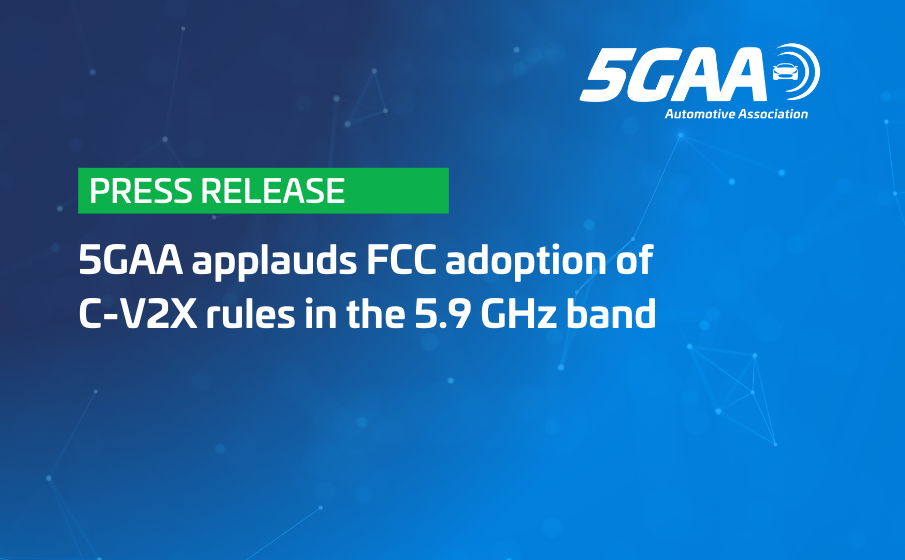
The 5G Automotive Association applauds FCC adoption of C-V2X rules in the 5.9 GHz band
WASHINGTON, D.C., 21 November 2024 – The 5G Automotive Association (5GAA) welcomes the U.S. Federal Communications Commission’s adoption of 5.9 GHz band rules allowing cellular vehicle-to-everything (C-V2X) equipment to support roadway safety communications technologies.
The dedicated spectrum will support C-V2X direct communications between vehicles and roadway infrastructure, cyclists, pedestrians and other vulnerable road users. It brings to closure a process initiated by 5GAA’s first petition for a waiver to the FCC in November 2018, requesting that C-V2X direct communications be allowed to operate at 5.9 GHz.
“Today’s FCC decision will enhance roadway, cyclist and pedestrian safety by enabling highly reliable and low-latency C-V2X communications,” said John Kwant, Executive Director, Americas, for 5GAA. “Now, for the first time in the United States, C-V2X can operate freely in the 5.9 GHz dedicated transportation safety spectrum in tandem with network connectivity to provide unparalleled safety alerts for greatly enhanced vehicle efficiency and awareness of roadway threats near or far, seen and unseen.”
The C-V2X ecosystem gains a new momentum with the FCC decision providing regulatory certainty to willing deployers and fueling the upcoming US DOT National V2X Deployment Plan, which 5GAA expects to set a clear vision and milestones to achieve the vision zero goal.
As the leading C-V2X industry proponent, 5GAA looks forward to working with its members and the greater automotive ecosystem to deploy this technology across the U.S.
About 5GAA
The 5G Automotive Association (5GAA) is a global, cross-industry organization of over 120 members, including leading global automakers, Tier-1 suppliers, mobile operators, semiconductor companies, and test equipment vendors. 5GAA members work together to develop end-to-end solutions for future mobility and transport services. 5GAA is committed to helping define and develop the next generation of connected mobility, automated vehicles, and intelligent transport solutions based on C-V2X. For more information, visit our website.
For more information, please contact:
- John Kwant: john.kwant@5gaa.org
- 5GAA Communications Team: marcom@5gaa.org
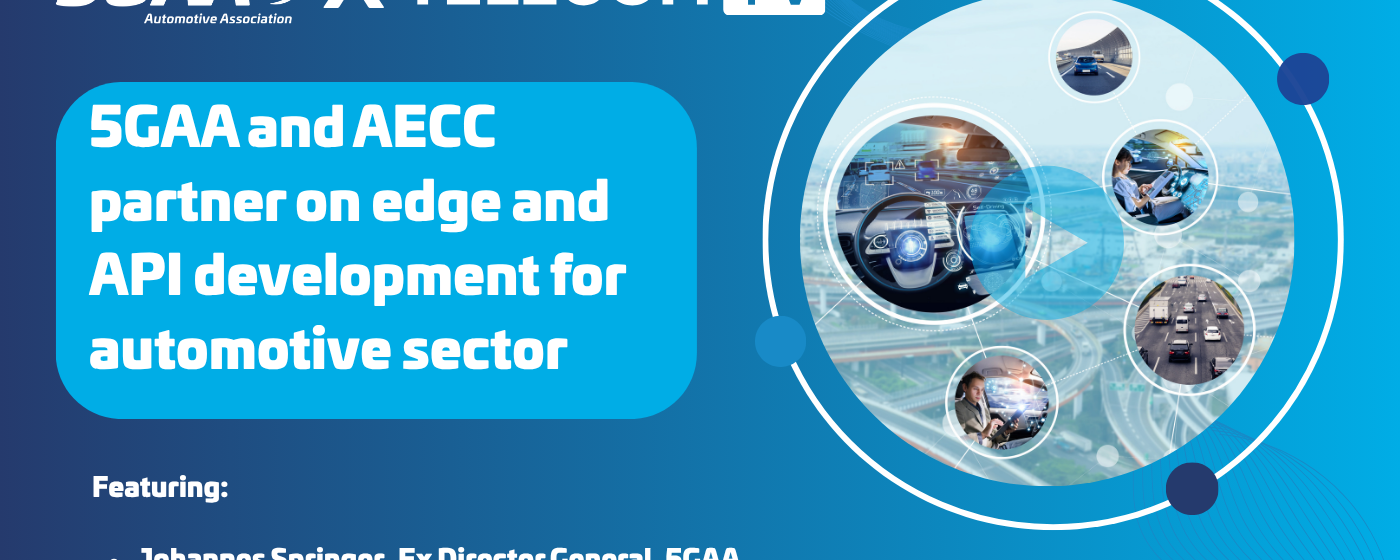
5GAA and AECC partner on edge and API development for automotive sector
Johannes Springer, 5GAA and Muriel Desaeger, AECC
Video interview by TelecomTV.
Since its formation in 2016, the 5GAA has been actively promoting the adoption of cellular vehicle-to-everything (C-V2X) as the key technology to deliver full connectivity to the automotive market. It brings together automotive manufacturers, Tier 1 suppliers, chipset and communication system providers, mobile operators and infrastructure vendors. During its conference in Berlin last week, the 5GAA signed a memorandum of understanding (MoU) with the Automotive Edge Computing Consortium (AECC) to facilitate cooperation around the use of multi-access edge computing (MEC), as well as the advancement of network APIs and their use by the mobility sector. The AECC is investigating the use and management of big data, mainly via the edge, to make it cost and time effective to the automotive industry. It has already entered into an agreement with the GSMA (read the full story here). Together, the two associations want to ensure that these new capabilities are available on a global basis, and harmonised across different countries and regions.
Featuring:
- Johannes Springer, Ex Director General, 5GAA
- Muriel Desaeger, AECC, and Technical Head of Electronic Engineering Division, Toyota
Recorded October 2024.

Meet Our Members – Interview with Jyoti Sharma, Verizon
In our ongoing “Meet Our Members” series, we explore the unique journeys and expertise of the individuals who make the 5G Automotive Association. Each interview sheds light onto the incredible work, vision, and passion of the people behind our organisation. You can check out our last conversation with Menno Malta, CEO of Monotch, here.
This time, we introduce Jyoti Sharma, Associate Director of Network Planning at Verizon and alternate board member at 5GAA since 2021. Jyoti has brought her deep industry insight to a range of work items, including Vehicle-to-Network-to-Everything (V2N2X) and has led initiatives such as the Vulnerable Road User (VRU) Demo. Her commitment to accelerating the large-scale deployment of V2X technologies make her a valuable contributor to the 5GAA, and we’re excited to learn more about her perspective on the future of 5G and MEC in transportation.
Could you tell us briefly about Verizon’s involvement in 5GAA and how your company benefits from being a member?
Verizon has been an active member of 5GAA since its inception. We started out as a general member and initially contributed at the working group level. We saw tremendous value in taking a leadership role in 5GAA as a major U.S. telecommunications provider and were elected by the members as a gold board member in 2021. Currently, Verizon is a platinum board member of 5GAA and we are playing a critical strategic role as one of the key stakeholders in the V2X ecosystem.
When did you first become part of the 5GAA board? What are some of your responsibilities, and what has been your most rewarding experience so far?
I represent Verizon on the 5GAA board as an alternate board member since 2021. In my role as a board member I have the privilege and responsibility to ensure 5GAA remains focused on key strategic focus areas which will accelerate a large-scale deployment of Vehicle-to-Everything (V2X) across the globe. My most rewarding experience has been to collaborate with other 5GAA members who are leaders from auto OEM customers, their tier 1 suppliers, chipset and module providers and other ecosystem partners. This technical collaboration between all the stakeholders is the key to drive innovation and unlock the full potential of V2X communications at scale and make it a reality.
Can you share any recent examples of how Verizon has collaborated with other 5GAA members to drive innovation in the industry?
Verizon has taken a leadership role in bringing the V2X ecosystem partners together under the 5GAA umbrella. We have demonstrated thought leadership in defining the network architecture to solve challenging V2X requirements leveraging key technology enablers such as 5G, multi-access edge computing (MEC) and Hyper Precise Location. Our recent V2X VRU (Vulnerable Road User) demo in Detroit showcasing interoperability between different network operators and application providers generated a very positive response and engagement from auto OEMs, Departments of Transportation and road operators. The demo was successful due to close collaboration with several 5GAA member companies.
As the lead of the VRU DEMO Work Item, could you elaborate on the significance of demonstrating interoperability in the context of Vulnerable Road User protection solutions?
VRU DEMO is one of the key strategic focus areas at the 5GAA board level that the industry has been trying to address for many decades. We believe the C-V2X and other technology enablers (5G, MEC, Hyper Precise Location) are ready to mitigate the number of road accidents involving vulnerable road users such as pedestrians and cyclists. In order to deploy such a VRU solution at scale it needs to work across multiple operators, multiple auto OEMs, multiple application providers and multiple cloud providers. We reached a significant milestone by demonstrating interoperability amongst different stakeholders and showcased the technology is ready to deploy at scale with existing networks. The learnings from the demo are being replicated in other parts of the world and are informing U.S. DOT V2X Deployment plans.
What criteria were used to select the specific use cases for demonstration in VRU DEMO? How did these use cases represent real-world scenarios and challenges?
There has been extensive discussion within 5GAA to define different VRU scenarios. Different flavors of VRU use cases have been documented in published technical reports. The demo team carefully selected most common real world VRU scenarios such as active pedestrian crossing alert and using roadside cameras and artificial intelligence, machine learning logic in the MEC to detect pedestrians and alert the drivers to avoid potential collision.
Verizon participated in the demos with a showcase of its network solution using multi-access edge computing. How does MEC differ from traditional network-based computing in terms of its benefits for VRU protection applications?
MEC allows us to bring traditional cloud compute and storage within the mobile network closer to the edge where the data is generated reducing the end to end latency. It is well established that MEC is a key differentiator and technology enabler for latency critical use cases such as VRU protection. Verizon has already deployed public MEC across the United States in partnership with cloud providers. We continue to drive innovation by developing standard MEC and Network APIs for application providers. During the VRU demo we demonstrated near real time VRU alerts over 5G and applications hosted on Verizon’s Detroit MEC.
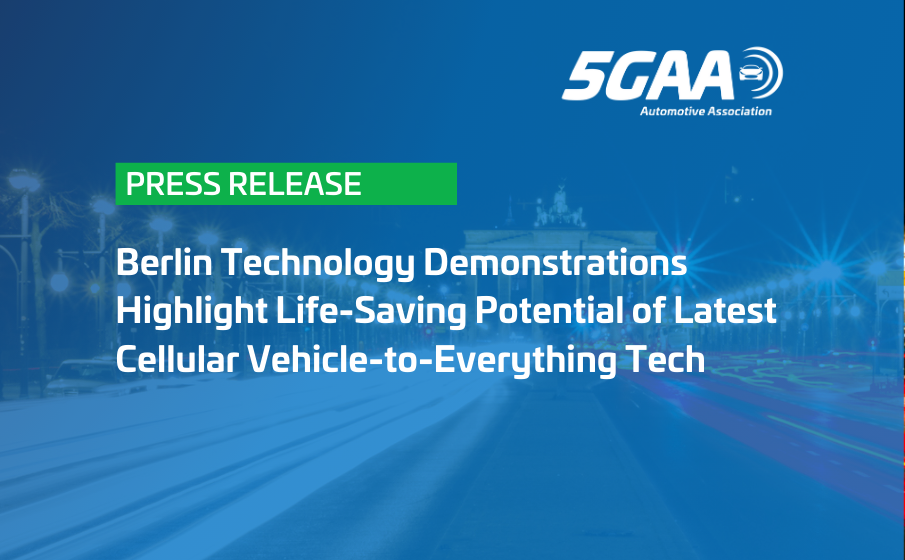
Berlin Technology Demonstrations Highlight Life-Saving Potential of Latest Cellular Vehicle-to-Everything Tech
BERLIN, 25 October 2024 – The 5G Automotive Association (5GAA) this week demonstrated the latest innovations in the Cellular Vehicle-to-Everything (C-V2X) technology family to help achieve “Vision Zero” for all road users. The demonstrations illustrated the potential of 5G-V2X to enable new use cases integrated across multiple automakers, service providers, and mobile network operators.
For the very first time, 5GAA demonstrated 5G-V2X Direct technology integration in Audi and BMW vehicles with the support of 5GAA members Autotalks, Bosch, Commsignia, and Fraunhofer FOKUS. This demonstration illustrated how technology can alert drivers about pedestrians and cyclists even before they can see them, leveraging sensors and a camera feed from other vehicles. The demonstrations showed the high bandwidth and low latency performance characteristics of 5G-V2X Direct using ETSI Release 2 messages.
5GAA members Bosch, Commsignia, Deutsche Telekom, Ericsson, Keysight Technologies, LG Electronics, Mercedes-Benz and Vodafone, and the Coalition for Cyclist Safety, showcased ready-to-deploy, interoperable applications to increase awareness of vulnerable road users and emergency vehicles on public roads in central Berlin. Safety awareness alerts were delivered via 4G and 5G networks with low latency thanks to Multi-Access-Edge Computing and precise positioning, as verified by Anritsu’sperformance measurements. ETSI-standardised messages were shared in real time between apps from various service providers.
“In Germany and across Europe, the ecosystem is ready to leverage the tens of millions of vehicles already connected via mobile networks and is now geared for the 2nd generation technology with 5G-V2X including direct communications,” said 5GAA Chairman Christoph Voigt.
Autotalks and Bosch, together with Commsignia, demonstrated the benefits of collective perception related to vulnerable road users. Ettifos, Keysight Technologies, Rohde & Schwarz and SEA Datentechnik also exhibited 5G-V2X Direct interoperability and conformity solutions and radio performance verification.
To show that C-V2X is about both safety and efficiency, Audi, supported by Commsignia and Autotalks, demonstrated a use case for “cooperative parking” based on 5G-V2X Direct.
In line with 5GAA’s Visionary 2030 Roadmap, 5G is continuously being deployed in many car models and 5G-V2X Direct is expected to be mass-deployed in commercial vehicle models as early as 2026. This week’s event underlined the continuous commitment of major European automakers to 5G-V2X following 5GAA’s Open Statement[1] in 2023.
About the 5GAA
The 5G Automotive Association (5GAA) is a global, cross-industry organization of more than 120 members, including leading global automakers, Tier-1 suppliers, mobile operators, semiconductor companies, and test equipment vendors. 5GAA members work together to develop end-to-end solutions for future mobility and transport services. 5GAA is committed to helping define and develop the next generation of connected mobility, automated vehicles, and intelligent transport solutions based on C-V2X. For more information about 5GAA, please visit www.5GAA.org.
For further information
Please see our brochure about the Berlin demonstrations here:https://5gaa.org/content/uploads/2024/10/5gaa-berlin-demos-brochure.pdf
Media contact: marcom@5GAA.org
[1] https://5gaa.org/content/uploads/2024/10/5gaa-open-letter-september-2023.pdf
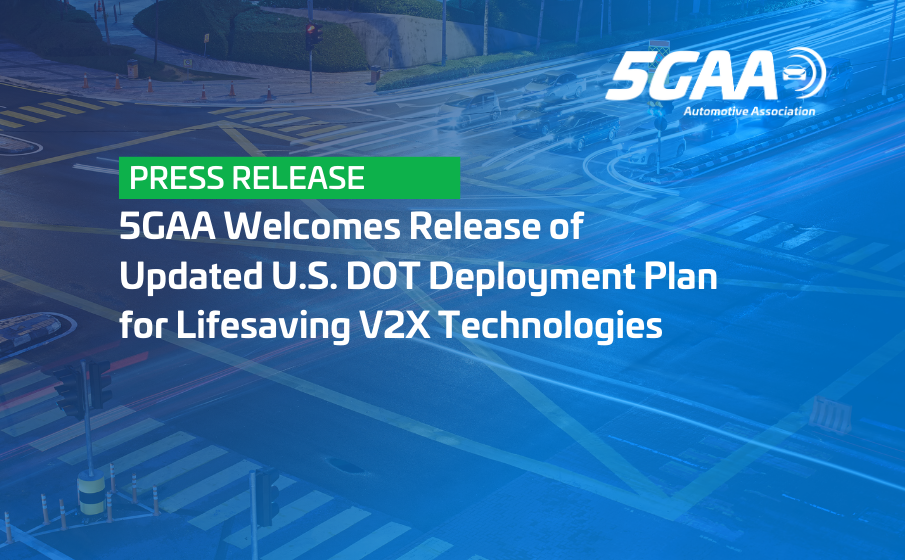
5GAA Welcomes Release of Updated U.S. DOT Deployment Plan for Lifesaving V2X Technologies
WASHINGTON, D.C., August 16, 2024 – The 5G Automotive Association (5GAA) welcomes the publication of the U.S. Department of Transportation’s updated V2X Deployment Plan and USDOT’s continuing commitment to the deployment of vehicle-to-everything (V2X) communications technologies on America’s roads.
The National V2X Deployment Plan outlines USDOT’s vision and specific milestones for the deployment of V2X. Cellular-vehicle-to-everything (C-V2X) technology allows cars, trucks and other vehicles to send important safety alerts with one another, with road infrastructure and with vulnerable road users securely and in real-time, with two complementary transmission modes (direct and mobile network communications).
“Today’s release establishes clear objectives for future public and private investments in V2X in U.S. road transportation networks,” said John F. Kwant, Executive Director, Americas, for 5GAA. “V2X technologies are key to enabling the deployment of connected motor vehicles and roadside infrastructure that can sharply reduce road fatalities, a key goal of the National Road Safety Strategy. “
Unlocking the full potential of V2X technologies requires as many road users, traffic signals and other traffic infrastructure as possible to be able to seamlessly communicate with one another and share information with a broader network. 5GAA believes that this requires the deployment to be nationwide, secure and interoperable, provide solutions for existing vehicles as well as new vehicles, and include interfaces for both C-V2X direct and network communications modes (cellular and non-terrestrial networks).
About 5GAA
The 5G Automotive Association (5GAA) is a global, cross-industry organization of over 120 members, including leading global automakers, Tier-1 suppliers, mobile operators, semiconductor companies, and test equipment vendors. 5GAA members work together to develop end-to-end solutions for future mobility and transport services. 5GAA is committed to helping define and develop the next generation of connected mobility, automated vehicle, and intelligent transport solutions based on C-V2X.
For more information, please contact:
- John Kwant: john.kwant@5gaa.org
- 5GAA Communications Team: marcom@5gaa.org


